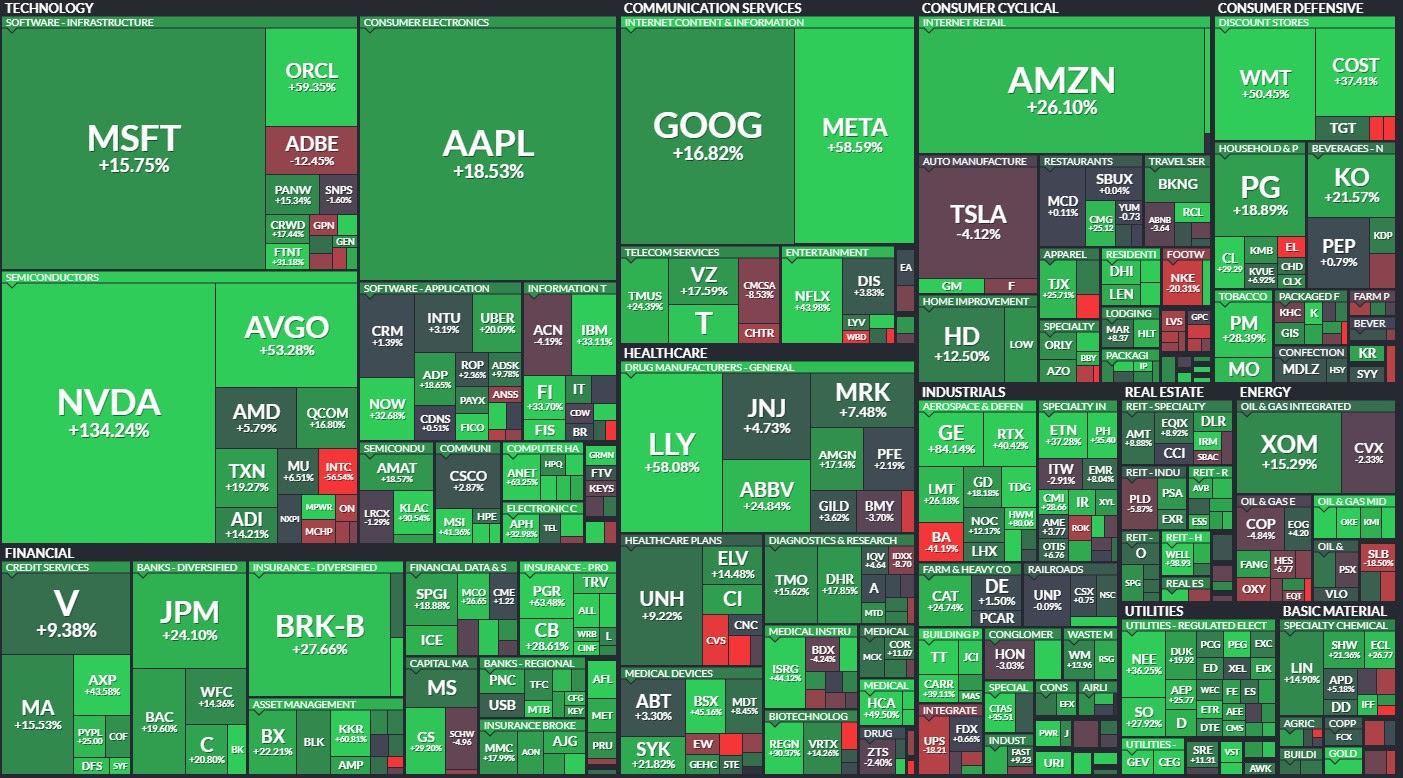S&P 500: +1.36% DOW: +1.62% NASDAQ: +1.49% 10-YR Yield: 3.74%
What Happened?
Markets finished the week on a positive note, driven largely by the Federal Reserve’s decision to cut interest rates by 0.50%, the first reduction since 2020. The Dow Jones gained 1.62%, hitting a record high on Friday, while the S&P 500 rose by 1.36%, and the Nasdaq climbed 1.49%. Despite gains in tech and energy sectors, including Intel and Nike, FedEx’s disappointing earnings, which fell over 15%, created some concerns. Investors viewed the rate cut as a proactive measure to sustain economic momentum amid ongoing inflation moderation.
In terms of sector performance, Energy (+3.7%), Financials (+2.6%), and Communications (+2.3%) led the way, while Real Estate (-12%) and Consumer Staples (-1.0%) struggled. Despite the overall gains, concerns linger about high market valuations, with the forward price-to-earnings (P/E) ratio for the S&P 500 now at 21.4, higher than its historical average. Additionally, analysts have revised earnings expectations downward for Q3, projecting 4.6% growth, compared to earlier estimates of 7.8%, reflecting a mixed sentiment on future market conditions.

Fed Cuts Rates By Half Percentage Point
- The Federal Reserve cut interest rates by 0.5%, lowering the benchmark rate to 4.75%-5%, signaling a shift in focus to the labor market.
- 11 of 12 Fed members supported the larger cut, with additional reductions expected by the year’s end.
- Stocks initially rose but closed lower as markets weighed the potential long-term effects of the rate cut.
The key takeaway – The Federal Reserve’s recent decision to lower the federal funds rate by 0.5%, to a range of 4.75%-5%, marks a strategic pivot from combating inflation to bolstering a weakening labor market. This reduction, the first since the early days of the pandemic in 2020, aims to mitigate potential economic slowdowns amid signs of labor market distress. With inflation rates moving closer to the Fed’s 2% target, yet unemployment concerns rising, the Fed has indicated further cuts, anticipating another full percentage point reduction by 2025 and a half-point in 2026. Following the announcement, the stock market experienced initial gains but eventually settled lower as the broader implications were absorbed by investors. This move signals a cautious yet proactive approach to fostering economic stability, with the Fed balancing inflation control against maintaining employment levels. As global central banks like Canada and the EU have also reduced rates, the Fed’s actions may influence further international monetary policy adjustments.

Retail Sales Rise Again And Show U.S. Economy Still On Solid Ground Ahead Of Fed Rate Cut
- Sales at retailers rose 0.1% last month, much better than the 0.2% expected decline
- Over the last 12 months, sales rose a modest 2.1%
- Sales fell in many areas simply due to a fall in the price of some goods
- Restaurant sales, a key indicator of consumer demand, were flat
The key takeaway – The best word to describe the August Retail Sales report is simply: “ok.” The data shows virtually flat retail figures, reflecting a consumer base that’s holding steady. There’s no cause for panic over economic concerns, but also no excitement about growth. A positive takeaway is that goods prices seem to be easing up slightly, offering some relief to consumers who have been hit hard by inflation in recent years. The Federal Reserve is watching out for any signs of economic health and this report is unlikely to tip the scales. As indicated in their commentary following this week’s interest rate decision, they have shifted focus, not only moving toward a rate-cutting cycle but also towards managing the unemployment picture more closely. Having largely tamed inflation, the question now is whether they can complete the final stretch of the soft landing race.

S&P 500 Earnings Expected To Grow 4.6% In Q3, Expanding For A Fifth Straight Quarter, FactSet Says
- The S&P 500 is expected to report 4.6% year-over-year earnings growth in Q3 2024, according to FactSet Research
- Information Technology, Health Care, and Communication Services sectors are leading growth, while the Energy sector is facing declines due to lower oil prices
- The forward 12-month P/E ratio for the S&P 500 stands at 21.4, above the 5-year and 10-year averages
The key takeaway – For the third quarter of 2024, the S&P 500 is predicted to experience a year-over-year earnings growth of 4.6%, marking it as the fifth consecutive quarter of growth, although this is a decrease from the earlier forecast of 7.8%. The forward 12-month price-to-earnings (P/E) ratio for the S&P 500 is higher than usual at 21.4, surpassing both the 5-year and 10-year averages, which reflects a relatively high valuation. Notably, sectors like Information Technology, Health Care, and Communication Services are leading in earnings growth projections, while the Energy sector faces the most significant declines, largely due to falling oil prices and decreased earnings estimates. This quarter also observed a mixed EPS guidance with 60 companies issuing negative forecasts and 50 positive, indicating varied sector performance and market expectations.

From Around the Watercooler
Intel’s Wild Week Leaves Wall Street More Uncertain Than Ever About Chipmaker’s Future
BOJ Governor Strikes Cautious Note Over Global Economic Outlook
Microsoft Deal Propels Three Mile Island Restart, With Key Permits Still Needed
Nike C.E.O. John Donahoe Abruptly Retires Amid Declining Sales



Comments are closed